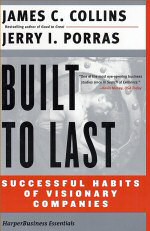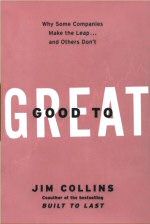So, let me summarize what we already discussed in the last posts (from 29th April to 9th Mai) concerning Corporate Entrepreneurship:
I would like now to share some very nice and interesting thoughts of Jim Collins concerning key success factors of great companies on the long run. Jim Collins wrote (among others) two central books:


The first book was published in 1994. Enclosed an extract from the amazon.com’s review:
This analysis of what makes great companies great has been hailed everywhere as an instant classic and one of the best business titles since In Search of Excellence. The authors, James C. Collins and Jerry I. Porras, spent six years in research, and they freely admit that their own preconceptions about business success were devastated by their actual findings–along with the preconceptions of virtually everyone else. […] The core myth, according to the authors, is that visionary companies must start with a great product and be pushed into the future by charismatic leaders. There are examples of that pattern, they admit: Johnson & Johnson, for one. But there are also just too many counterexamples–in fact, the majority of the “visionary” companies, including giants like 3M, Sony, and TI, don’t fit the model. They were characterized by total lack of an initial business plan or key idea and by remarkably self-effacing leaders. Collins and Porras are much more impressed with something else they shared: an almost cult-like devotion to a “core ideology” or identity, and active indoctrination of employees into “ideologically commitment” to the company.
I definitely like these ideas :-)
The second book was written in 2001. Enclosed an extract of the book description:
The Challenge
Built to Last, the defining management study of the nineties, showed how great companies triumph over time and how long-term sustained performance can be engineered into the DNA of an enterprise from the verybeginning. But what about the company that is not born with great DNA? How can good companies, mediocre companies, even bad companies achieve enduring greatness?
The Study
For years, this question preyed on the mind of Jim Collins. Are there companies that defy gravity and convert long-term mediocrity or worse into long-term superiority? And if so, what are the universal distinguishing characteristics that cause a company to go from good to great?
The Findings
The findings of the Good to Great study will surprise many readers and shed light on virtually every area of management strategy and practice.
I would like to invest some time in the coming posts to discuss some of the innovative and disturbing findings of Jim Collins:
